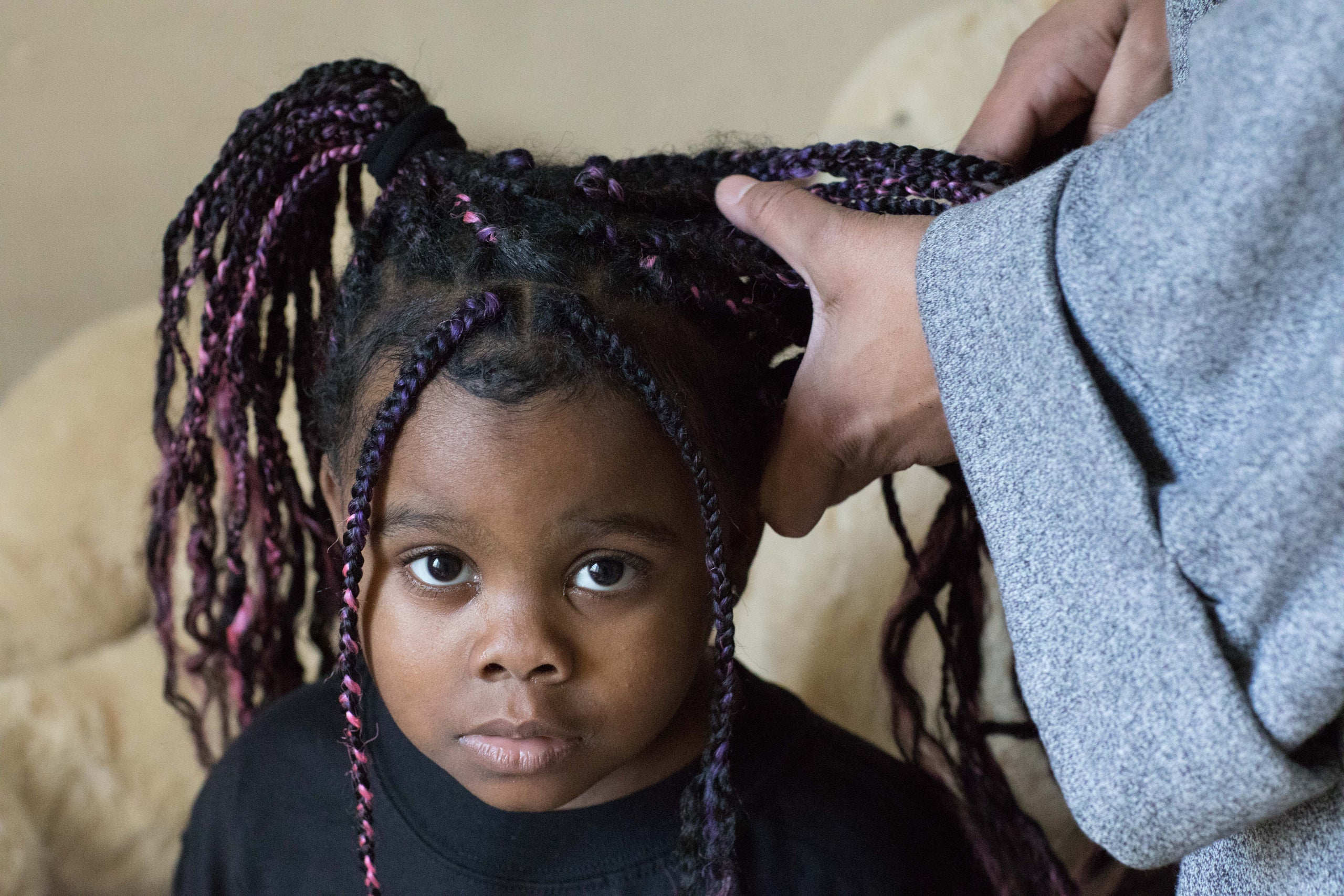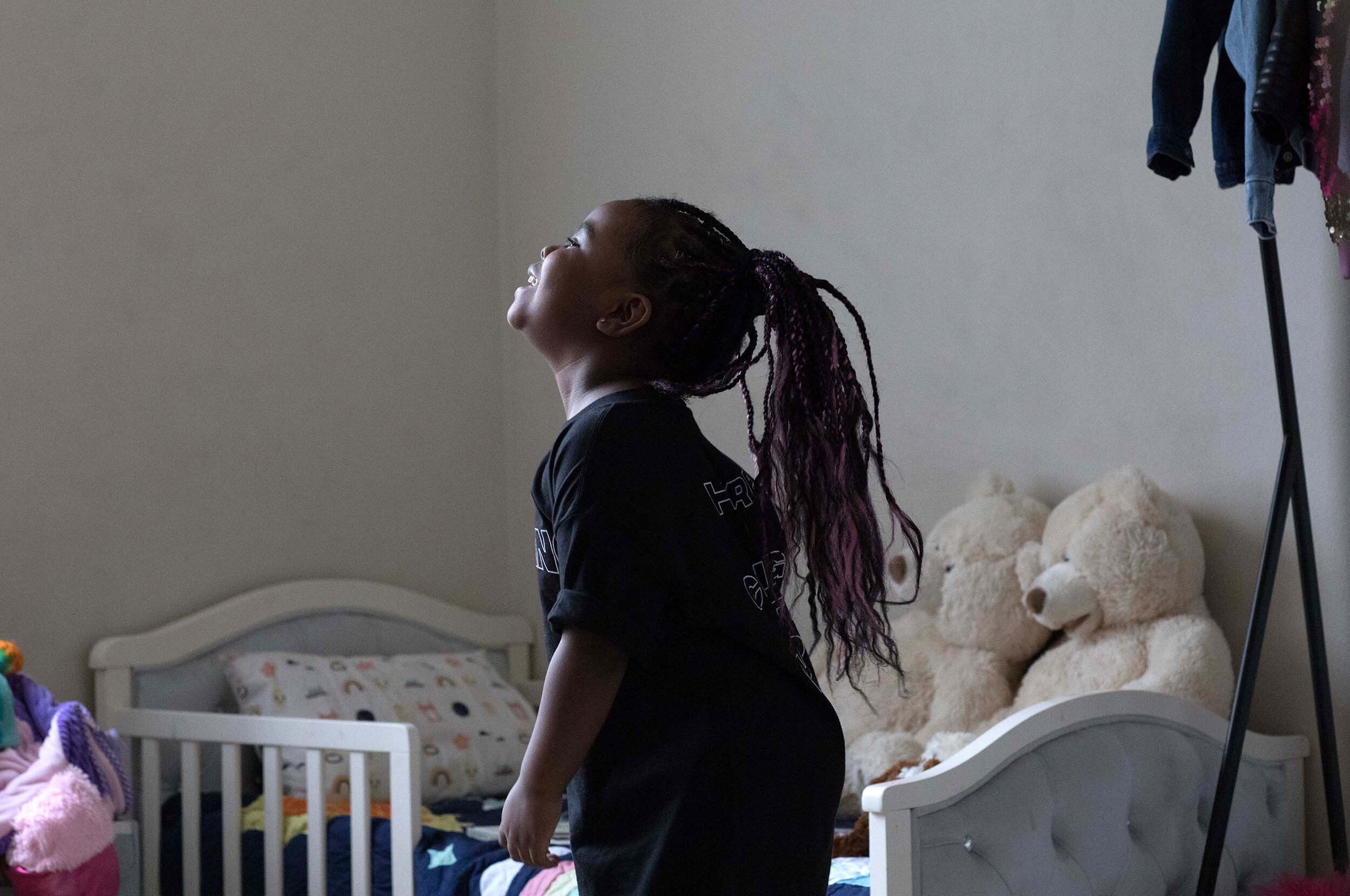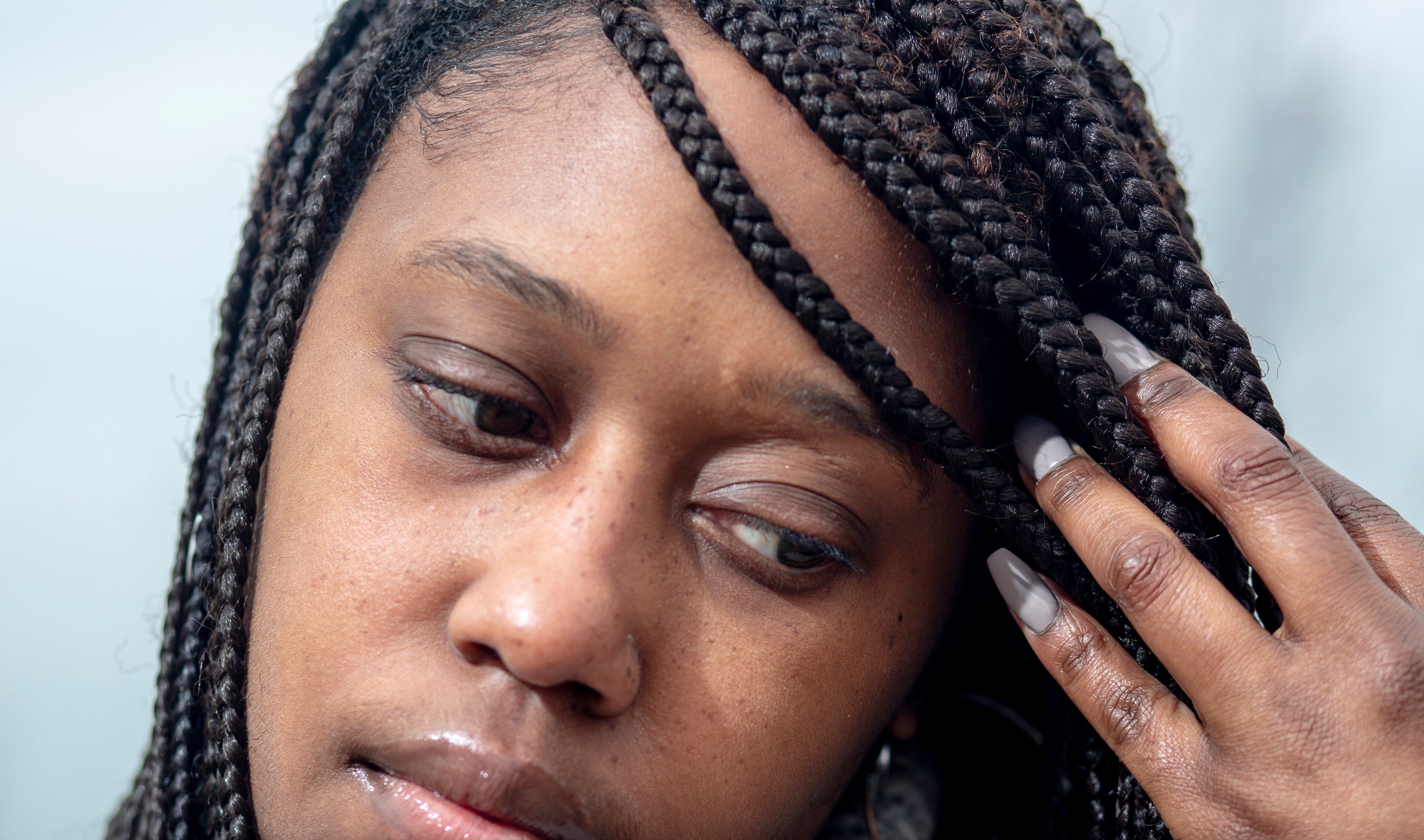Above: ChaKara Gunn, 30, at Marquette Park in Gary, Indiana, on Jan. 26.
When ChaKara Gunn was diagnosed with Stage 3 breast cancer in late 2018, it was a complete shock.
The Gary, Indiana, native, who had given birth to twin boys eight months earlier, didn’t have a family history of the disease. Plus, she was only 28 at the time and, in her mind, she couldn’t have been the face of this disease.
But after finding a large lump in her breast during a monthly self-exam, she got it checked out. Perhaps it wasn’t just a blocked duct, as her mother suggested. After a mammogram, ultrasound and biopsy on the same day, she got the news no one wants to hear. She had invasive ductal carcinoma, the most common form of breast cancer.
Her oncologist said she needed to start chemotherapy and start it soon.
“It all happened so fast. I remember crying the night I was diagnosed and that night only because I didn’t have time to wallow in it,” Gunn, now 30, told HuffPost. “I had to live for my boys and take care of them and beat this.”
Though Gunn knew hair loss was a side effect of her cancer treatment, she had no idea it would happen so fast.
“My hair relaxed was down my back, so I thought, oh, a little will come out and I can still put it in a ponytail,” she said. “But one day my mom was combing my hair and it was coming out in chunks. She didn’t even have the heart to tell me.”
“She just told me to take a shower. When I did, I saw that all my hair was coming out. Looking in the mirror, I couldn’t even recognize myself.”
“It was very traumatic.”
But Gunn is not alone. As Slate’s Julia Craven recently pointed out, though there’s not a lot of research about Black women and hair loss, with most of it centered on traction alopecia (caused by pulling on the hair with tight braids and styles), studies have suggested that nearly 50% of Black women experience some type of hair loss in their life. A 2018 study suggested that Black women are also less likely to seek help and that many dermatologists are not culturally competent and adequately equipped to address their medical needs.
For African-American women, it’s not a secret that hair — and the loss of it —carries a hefty weight culturally and emotionally. Hair often signifies a sense of pride, acceptance and femininity. It’s also often a source of discrimination; Black people across the country have lost jobs and been kicked out of school for their hair. When it’s gone, it can lead to shame.
Even when Congresswoman Ayanna Pressley recently revealed her battle with alopecia, the popular and influential Democrat from Massachusetts admitted she felt humiliated, using wigs to cover up her severe hair loss.
“I hid in a bathroom stall. I felt naked, exposed, vulnerable. I felt embarrassed. I felt ashamed. I felt betrayed,” she told The Root in January.
But for women like Gunn, whose hair loss is linked to a life-altering health issue, one that could possibly even lead to death, how does that play into Black women’s already complicated relationship with their tresses?
Reconciling Hair Trauma With Health
For Stephanie Silberman, 55, there have been times when looking in the mirror has “been devastating” because hair loss has dominated her life for a decade due to hyperthyroidism.
Let the Green Cove Springs, Florida, mother and grandmother tell you, she always had a full set of eyebrows and a full head of hair until she noticed about 10 years ago that something was off. What started out feeling like a cold and a raspy voice escalated into her not being able to swallow, even causing her to choke even while drinking water.
An MRI detected a non-cancerous growth on her thyroid, and she was urged to get it removed. But shortly after the surgery, her eyebrows started thinning furiously and then her hair started to fall out. She began to wear wigs.
But the 23-year Navy veteran believes her hair loss is also a result of a string of Veterans Affairs doctors refusing to take her seriously or put her on medication.
“They kept telling me I didn’t need medicine [that others with this disease might get] because my numbers were ‘normal,’ but I never had hair loss until after my surgery,” she said.
“I would see myself in the mirror and ask, ‘What in the hell is going on?’ My eyebrows were looking like that creepy-ass woman from ‘Poltergeist,’” she said, laughing.
“I can joke about it now, but it was rough. I felt awful. I couldn’t sleep. I gained all this weight. I didn’t feel like my normal self because of my thyroid. I thought I was going crazy. I even contemplated suicide.
“I don’t think my husband even knows that.”
Silberman, who has still not been prescribed thyroid medication but plans to see a specialist outside her network, is now doing much better thanks to a restrictive diet, rigorous exercise routine and vitamins. But she admitted that dealing with her health and her hair loss had been a tricky balancing act.
“Yeah, I was feeling horrible and depressed about my health, but I also didn’t like the way I looked. My husband would tell me I looked amazing, but I always thought he was lying. I didn’t feel feminine. I didn’t feel sexy.”
For Gunn, she said she felt conflicted about being self-conscious about her hair because she didn’t want to appear vain.
“In the beginning, I wouldn’t even want to open the door for the mailman to even see me,” she said. “My boyfriend was supportive and told me I was beautiful but would also tell me to not worry about my hair and focus on my health, which makes sense.”
“But I still don’t think people understand that we’re not only fighting for our life, but we’re dealing with other side effects, too. I was going through heat flashes. My nails changed colors; one fell off. My body is changing. I still gotta be a mom, maintain my job and so much is changing. I felt like I was losing myself, my control, and then the hair, that was too much.”
Mother and Oakland native Kala Langston can relate. However, those concerns weren’t for herself but for her 4-year-old daughter, Nova, who was diagnosed with cancer in January 2018.

Langston, 30, describes the time before Nova’s diagnosis as a “roller coaster ride,” having to take the 2-year-old to the ER three to four times, believing she had the flu and encountering doctors who “really weren’t listening” to her.
But on their last visit, a doctor suggested checking her blood levels. Twenty-four hours later, Nova was diagnosed with acute lymphoblastic leukemia, a common form of blood cancer. However, a member of Nova’s medical team suggested that maybe her non-genetic case was a result of the wildfires in California and the carcinogens they leave behind.
Langston admitted that for the young first-time mom, it was a terrifying time.
“Honestly, it was the scariest thing. I couldn’t control her cancer. But I definitely learned a lot from this, as a mother, to be more patient, more attentive and just allow myself to be in the moment,” she recalled.
Clearly, Langston’s priority was her child’s health, but given that cancer treatment was on the horizon, she did wonder if her baby girl’s self-esteem would suffer when they’d have to shave off her curly fro.
“Her dad was supportive, but he also told me I may be overthinking it,” she said, remembering how important her hair was to her as a little girl. “I was just so anxious. Is she going to freak out? Are people going to be staring at her?”
“I wanted to let her know that she’s going to be fine and rock her short look and that she doesn’t need to have long hair in order to be pretty.”
Soon after Nova started treatment, her hair began to thin around the edges and then “starting coming out in clumps.” That’s when she enlisted the help of her barber friend to come over and shave Nova’s head. The 2-year-old was “unbothered.”
“It was much easier for her than I thought it was for me. She was never really insecure about her hair because we made sure she was surrounded by people who looked like her, which included my cutting my hair off and my mom who also had short hair,” Langston stressed.

In addition, she made sure she encouraged healthy self-expression for Nova, especially when going through chemotherapy, and made sure she was surrounded with Black books so the toddler could be empowered by seeing images that reflected her.
Initially, Langston used colorful headbands to adorn her beautiful daughter’s bald scalp, but for the past year, Nova’s hair has been growing back. Now she and Langston have fun with it.
“Now that’s she older, she’s become more opinionated and aware of what she wants, wanting certain hairstyles that she would see on characters from TV shows she watches,” Langston said. “Currently it’s in pink and purple box braids, and she’s always asking me to style it in new ways. She also gets really excited when she sees other Black girls and women with braids, too.”
Even better? Nova’s prognosis is extremely encouraging. She’s in remission, and treatment is ending this spring.
“She will be done on March 30, and so now it’s about maintenance, recovery and many checkups after chemotherapy, including getting her heart checked, too,” she said.
“It’s been an emotional journey, with trips to the ER because Nova was sensitive to her chemo. But we’re definitely blessed that we’re in the home stretch.”
Hair May Gone, But Not All Is Lost
Langston is right, long hair doesn’t define one’s beauty, but the journey to realizing that isn’t always easy. For Gunn, who is currently in remission, she spent months hiding her bald head, even from the mailman she says, with chic turbans and scarves. But when summer hit, she realized that wasn’t feasible.

“I was the wrap queen, but I was going through hot flashes, and it was hot outside, I just knew that wasn’t going to work,” Gunn said. “I had to just embrace my bald. It wasn’t easy, but I got there.”
By August 2019, her hair, which she said was a completely different texture than before, grew into a teeny-weeny Afro (also called a TWA), and she was experimenting with fades and Mohawks, but now she’s wearing braids.
“I like the braids; they are low maintenance, I don’t like to get up early and do my hair, and natural hair is a lot of work. I don’t have time to watch all the YouTube videos, and my twist-outs looked weird,” she joked.
But looking back, Gunn said, there is one thing she would have done differently.
“I should have shaved my head before all my hair fell out. I should have been in control.”
Silberman’s path to coping has been a little harder. She admitted that she has spent “close to $2,000” on eyebrow treatments, such as microblading, which sadly haven’t worked.
When it comes to brows, “it doesn’t get any easier. I still haven’t found an [effective] way of doing them,” she said. “I am still spending 30-45 minutes every morning putting them on if I don’t get them right the first time. I don’t want to be out there looking for any kind of way.”
Yet, with the help of her stylist, who understands her hair issues, she’s found a bit of solace and has ditched the wigs that she said just “slip off.”
“Right now, I get a crocheted hairstyle every two weeks,” Silberman said. “My stylist will braid my hair, and it’s less stress on it. Yes, it’s still coming out, but not at an alarming rate it was before. So whatever she is doing is working, which is key.”
For Langston, she will continue to lead by example and encourage Nova to express herself through her personal style, hair and art.
“I want her to be comfortable to express herself with her hair, now nothing too crazy. I want for her to be creative and free.”
Calling all HuffPost superfans!
Sign up for membership to become a founding member and help shape HuffPost’s next chapter
Credit: Source link